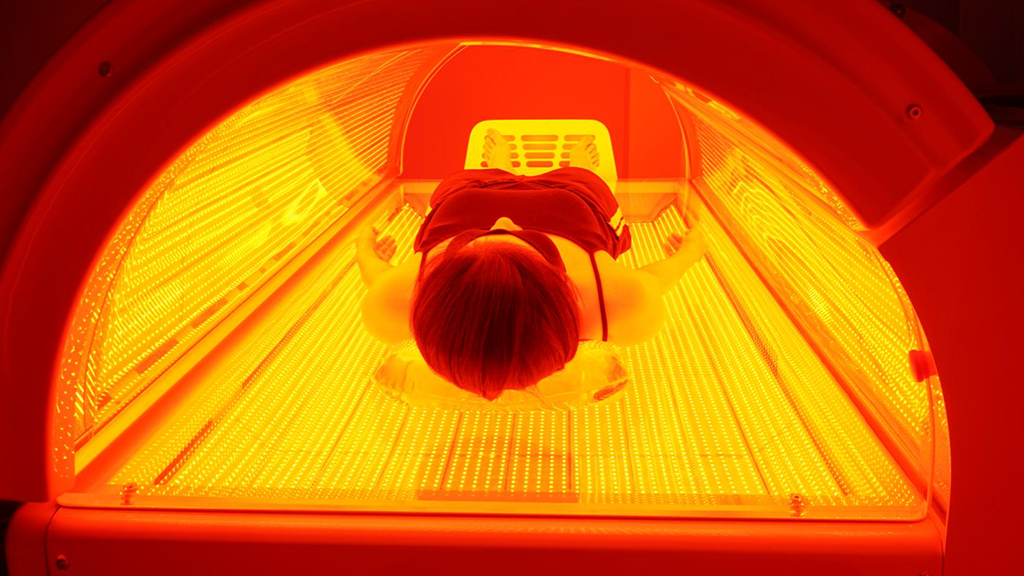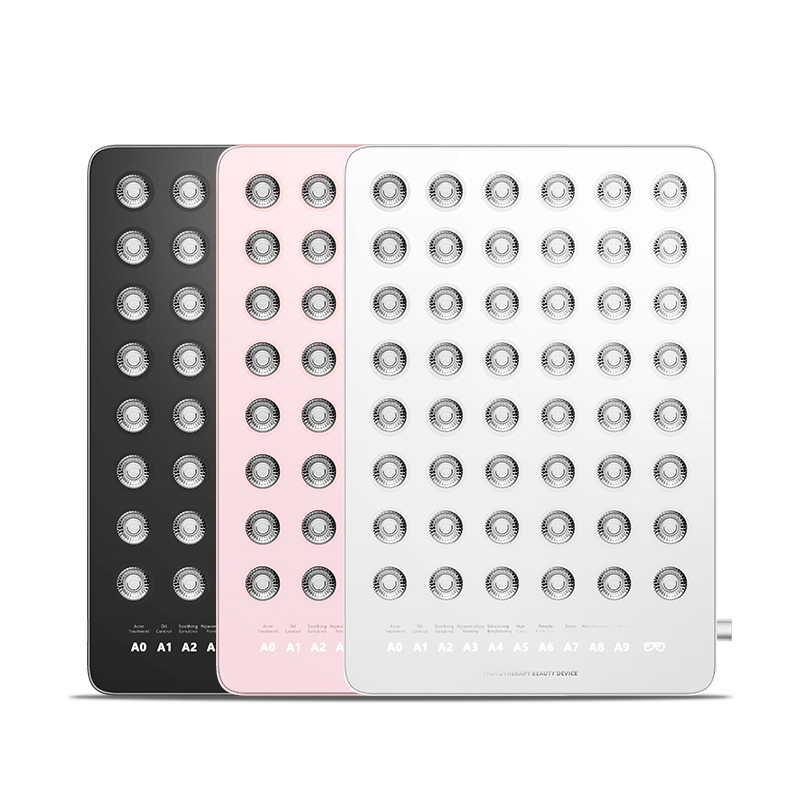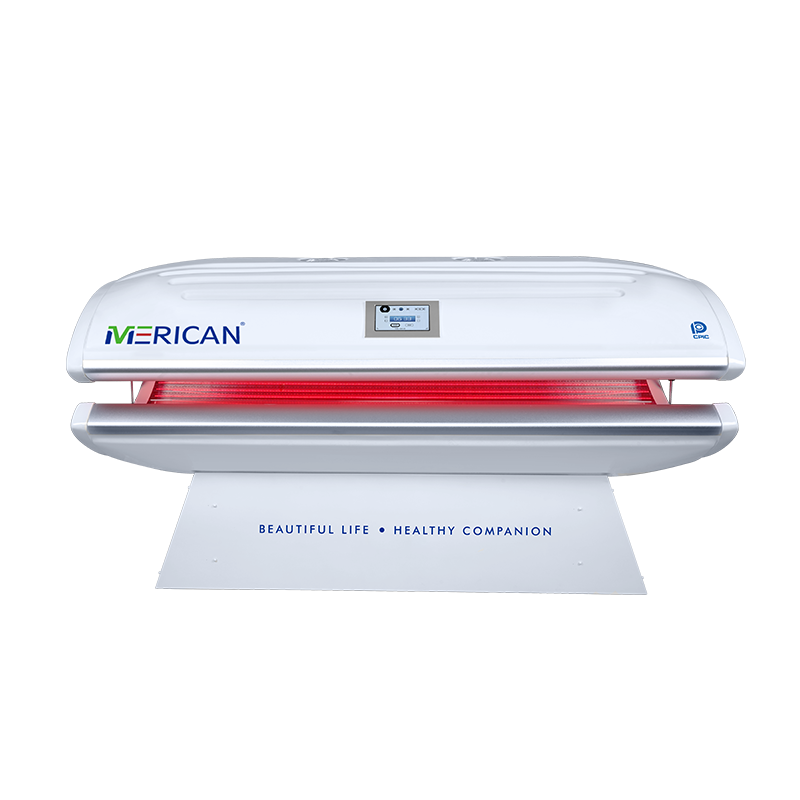यदि आप अपने स्वास्थ्य को बढ़ावा देने के लिए नवीन तरीकों के लिए वेब खंगाल रहे हैं, हो सकता है कि आपकी नज़र लाल बत्ती थेरेपी बिस्तरों के आसपास की चर्चा पर पड़ी हो. ये दिलचस्प उपकरण चमकती त्वचा से लेकर मांसपेशियों की बेहतर रिकवरी तक हर चीज़ का वादा करते हैं, यह सब केवल लाल बत्ती में स्नान करके. लेकिन वास्तव में लाल बत्ती वाला बिस्तर क्या है?, और क्या यह वास्तव में प्रचार पर खरा उतरता है? आइए जानें कि रेड लाइट थेरेपी बेड क्या है और रेड लाइट थेरेपी बेड के फायदे जानें.
लाल प्रकाश चिकित्सा क्या है?

इससे पहले कि हम रेड लाइट थेरेपी बेड की बारीकियों में उतरें, रेड लाइट थेरेपी की मूल बातें समझना आवश्यक है (आरएलटी). इसलिए, यह क्या है? सामान्य शर्तों में, आरएलटी एक उपचार है जो आपकी त्वचा में प्रवेश करने के लिए लाल प्रकाश की निम्न-स्तरीय तरंग दैर्ध्य का उपयोग करता है. हानिकारक UV किरणों के विपरीत, यह प्रकाश टैनिंग के बारे में नहीं है बल्कि उपचार और कायाकल्प के बारे में है. शुरुआत में नासा द्वारा अंतरिक्ष में पौधे उगाने में मदद के लिए इसकी खोज की गई थी, लाल बत्ती थेरेपी पिछले कुछ वर्षों में विकसित हुई है. अब इसका उपयोग विभिन्न चिकित्सा और कॉस्मेटिक सेटिंग्स में किया जाता है, ऊतक की मरम्मत करने की इसकी क्षमता के लिए धन्यवाद, सूजन कम करना, और कोलेजन उत्पादन को भी बढ़ावा देता है.
रेड लाइट थेरेपी कैसे काम करती है?
इसलिए, आपकी त्वचा पर चमकने से इन सभी स्वास्थ्य लाभों में कैसे परिवर्तन होता है? जादू इस बात में निहित है कि लाल प्रकाश आपके शरीर के साथ किस प्रकार संपर्क करता है. जब प्रकाश आपकी त्वचा में प्रवेश करता है, यह आपकी कोशिकाओं तक पहुंचता है’ माइटोकॉन्ड्रिया, इसे अक्सर कोशिका का पावरहाउस कहा जाता है. यह प्रकाश माइटोकॉन्ड्रिया को सक्रिय करता है, जो बदले में अधिक ऊर्जा पैदा करता है. इसे ऐसे समझें जैसे आपकी कोशिकाओं को थोड़ा कैफीन को बढ़ावा देना, उन्हें अधिक कुशलता से काम करने की अनुमति देना. ऊर्जा में यह वृद्धि आपके शरीर को क्षति की मरम्मत में मदद करती है, सूजन कम करना, और त्वचा कोशिकाओं को फिर से जीवंत करता है. अनिवार्य रूप से, लाल बत्ती थेरेपी आपके शरीर को खुद को ठीक करने के लिए प्रोत्साहित करती है - बढ़िया, सही?
रेड लाइट थेरेपी बेड क्या है??

अब चूँकि हमने मूल बातें कवर कर ली हैं, चलिए शो के स्टार की ओर बढ़ते हैं: the लाल बत्ती चिकित्सा बिस्तर. इसलिए, लाल बत्ती बिस्तर क्या है? एक कमाना बिस्तर की कल्पना करो, लेकिन इसके बजाय आपको धूप में चूमती हुई चमक मिलेगी, यह आपको उपचारात्मक लाल रोशनी से नहलाता है. ये बिस्तर पूरे शरीर को रेड लाइट थेरेपी का अनुभव प्रदान करने के लिए डिज़ाइन किए गए हैं, इससे एक बार में बड़े क्षेत्रों को लक्षित करना सुविधाजनक हो जाता है. चाहे आप दुखती मांसपेशियों को आराम देना चाह रहे हों, अपनी त्वचा में सुधार करें, या बस अपने समग्र स्वास्थ्य को बढ़ावा दें, लाल बत्ती वाले बिस्तर पर लेटने से एक ही सत्र में ये लाभ मिल सकते हैं.
रेड लाइट थेरेपी बिस्तर का तंत्र

तरंग दैर्ध्य और प्रकाश स्पेक्ट्रम
सभी प्रकाश समान नहीं बनाए गए हैं. लाल बत्ती बिस्तर की प्रभावशीलता काफी हद तक उसके द्वारा उत्सर्जित तरंग दैर्ध्य पर निर्भर करती है. आम तौर पर, ये एलईडी थेरेपी बेड प्रकाश का उपयोग करते हैं 600 को 900 नैनोमीटर रेंज, जो त्वचा में प्रवेश करने और सेलुलर गतिविधि को उत्तेजित करने के लिए इष्टतम है. इस रेंज में शामिल हैं लाल और निकट-अवरक्त प्रकाश दोनों, प्रत्येक अद्वितीय लाभ प्रदान करता है—लाल बत्ती त्वचा कायाकल्प जैसे सतह-स्तरीय उपचारों के लिए बहुत अच्छी है, जबकि निकट-अवरक्त प्रकाश मांसपेशियों और जोड़ों में गहराई तक प्रवेश करता है.
लाल रोशनी त्वचा में कैसे प्रवेश करती है??
आप सोच रहे होंगे, बिना नुकसान पहुंचाए प्रकाश आपकी त्वचा में कैसे प्रवेश करता है?? इसका उत्तर लाल और निकट-अवरक्त प्रकाश की गैर-आक्रामक प्रकृति में निहित है. यूवी किरणों के विपरीत, जो आपकी त्वचा को जला और नुकसान पहुंचा सकता है, लाल प्रकाश धीरे-धीरे कुछ मिलीमीटर तक प्रवेश कर जाता है, बिना नुकसान पहुंचाए सतह के नीचे की कोशिकाओं को लक्षित करना. यह जलने के जोखिम के बिना सूरज की गर्मी को सोखने जैसा है.
सेलुलर प्रभाव: माइटोकॉन्ड्रियल उत्तेजना
सेलुलर स्तर पर, रेड लाइट थेरेपी माइटोकॉन्ड्रिया को उत्तेजित करके काम करती है. जब ये “ताकतवर” लाल प्रकाश को अवशोषित करें, वे एडेनोसिन ट्राइफॉस्फेट का उत्पादन करने में अधिक कुशल हो जाते हैं (एटीपी), कोशिका की ऊर्जा मुद्रा. अधिक एटीपी का अर्थ है ऊतकों की मरम्मत जैसे महत्वपूर्ण कार्य करने के लिए कोशिकाओं के लिए अधिक ऊर्जा, सूजन को कम करना, और समग्र सेलुलर स्वास्थ्य को बढ़ावा देना.
कोलेजन उत्पादन बढ़ाना
कोलेजन वह प्रोटीन है जो आपकी त्वचा को युवा और दृढ़ बनाए रखता है, लेकिन जैसे-जैसे हमारी उम्र बढ़ती है, हमारा शरीर इसका कम उत्पादन करता है. रेड लाइट थेरेपी फ़ाइब्रोब्लास्ट को उत्तेजित करके इस प्रक्रिया को उलटने में मदद कर सकती है, कोलेजन उत्पादन के लिए जिम्मेदार कोशिकाएं. लाल बत्ती वाले बिस्तर पर नियमित सत्र से आराम मिल सकता है, समय के साथ अधिक युवा त्वचा.
रेड लाइट थेरेपी बिस्तर का उपयोग कैसे करें?
आरएलटी का उपयोग कितनी बार करें?
जब लाल बत्ती चिकित्सा की बात आती है तो निरंतरता महत्वपूर्ण है. अधिकांश लोगों के लिए, बिस्तर का उपयोग करना 2 को 3 सप्ताह में कई बार सर्वोत्तम परिणाम मिलते हैं. आम तौर पर, के बीच सत्र चलता है 10 को 20 मिनट, आपके लक्ष्यों पर निर्भर करता है. त्वचा के कायाकल्प के लिए, कम, more frequent sessions (के बारे में 3 को 5 प्रति सप्ताह समय) are recommended. For deeper tissue healing or muscle recovery, longer sessions less frequently (2 को 3 प्रति सप्ताह समय) may be more effective.
Pre- and Post-Treatment Care
To maximize the benefits of your red light therapy bed, it’s important to follow some simple pre- and post-treatment care steps. Before your session, make sure your skin is clean and free of any lotions or oils, as these can block the light. आपके सत्र के बाद, hydrate your skin with a moisturizer to lock in the benefits and help your skin recover.
Combining Red Light Therapy with Other Treatments
Red light therapy is versatile and can be easily combined with other treatments. उदाहरण के लिए, you can use it alongside topical skincare treatments to enhance their absorption and effectiveness. It’s also a great complement to physical therapy for muscle recovery, दर्द को कम करने और उपचार में तेजी लाने में मदद करना.
रेड लाइट थेरेपी बेड के स्वास्थ्य और कल्याण लाभ

त्वचा का स्वास्थ्य और कायाकल्प
आपकी त्वचा आपका सबसे बड़ा अंग है, और यह तत्वों के दैनिक संपर्क से प्रभावित होता है. रेड लाइट थेरेपी बेड कोलेजन उत्पादन को बढ़ाकर और परिसंचरण में सुधार करके आपकी त्वचा को फिर से जीवंत करने में मदद कर सकते हैं.
रेड लाइट थेरेपी के सबसे लोकप्रिय उपयोगों में से एक इसके बुढ़ापे-विरोधी लाभों के लिए है. बढ़ा हुआ कोलेजन उत्पादन मदद करता है झुर्रियों और महीन रेखाओं की उपस्थिति को कम करें, आपकी त्वचा को मुलायम बनाता है, अधिक युवा उपस्थिति.
यदि आप संघर्ष कर रहे हैं मुँहासा या घाव, रेड लाइट थेरेपी सूजन को कम करने और क्षतिग्रस्त त्वचा के ऊतकों के तेजी से उपचार को बढ़ावा देने में मदद कर सकती है. यह स्वाभाविक है, अपना रंग साफ करने का गैर-आक्रामक तरीका.
दर्द से राहत और सूजन में कमी
पुराने दर्द या सूजन के साथ रहना? रेड लाइट थेरेपी बेड सेलुलर स्तर पर सूजन को कम करके राहत दे सकते हैं. कोशिकाओं में ऊर्जा उत्पादन बढ़ने से आपके शरीर को दर्द से लड़ने में मदद मिलती है और तेजी से रिकवरी को बढ़ावा मिलता है.
मांसपेशियों की रिकवरी और एथलेटिक प्रदर्शन
एथलीट अपने प्रदर्शन को बेहतर बनाने और रिकवरी में तेजी लाने के लिए तेजी से रेड लाइट थेरेपी की ओर रुख कर रहे हैं. प्रकाश मांसपेशियों के ऊतकों में गहराई तक प्रवेश करता है, रक्त प्रवाह को बढ़ाकर और ऑक्सीडेटिव तनाव को कम करके दर्द को कम करने और सहनशक्ति में सुधार करने में मदद करता है.
प्रतिरक्षा प्रणाली समर्थन
आपकी प्रतिरक्षा प्रणाली आपके शरीर की रक्षा तंत्र है, और इसे मजबूत बनाए रखना महत्वपूर्ण है. रेड लाइट थेरेपी को प्रतिरक्षा कोशिकाओं के उत्पादन को उत्तेजित करके और ऑक्सीडेटिव तनाव को कम करके प्रतिरक्षा समारोह को बढ़ाने में दिखाया गया है.
Mental Health Benefits: मूड और नींद में सुधार
Struggling with mood swings or sleep issues? Red light therapy can help by regulating your body’s production of melatonin, the hormone responsible for sleep. Regular sessions can improve sleep quality and stabilize your mood, leaving you feeling more balanced and rested.
Specific Use Cases for Red Light Therapy Beds
Red Light Therapy for Anti-Aging
Aging is inevitable, but red light therapy can help slow down the process. By boosting collagen production and improving skin elasticity, regular sessions in a red light bed can keep your skin looking younger, longer.
Red Light Therapy for Weight Loss
While not a magic bullet, red light therapy can support weight loss efforts by reducing inflammation and improving metabolism. Combined with a healthy diet and regular exercise, it can help you shed those stubborn pounds.
बालों के विकास के लिए रेड लाइट थेरेपी
Dealing with thinning hair? Red light therapy might be the answer. The increased blood flow to the scalp can stimulate hair follicles and promote new growth, offering a natural solution to hair loss.
Red Light Therapy for Chronic Conditions (उदा।, वात रोग)
If you suffer from chronic conditions like arthritis, red light therapy can provide relief by reducing inflammation and promoting joint health. यह स्वाभाविक है, drug-free way to manage pain and improve mobility.
Comparing Red Light Therapy Beds to Other RLT Devices

Red Light Therapy Bed vs. हाथ से चलने वाले उपकरण
Handheld devices are great for targeting small areas, but if you’re looking for full-body benefits, a red light bed is the way to go. It offers comprehensive coverage, व्यापक दर्द या त्वचा संबंधी समस्याओं से पीड़ित लोगों के लिए यह इसे आदर्श बनाता है.
Red Light Therapy Bed vs. चेहरे का मास्क
त्वचा के उपचार के लिए फेस मास्क लोकप्रिय हैं, लेकिन वे केवल आपका चेहरा ढकते हैं. एक लाल बत्ती चिकित्सा बिस्तर, वहीं दूसरी ओर, पूर्ण-शरीर एक्सपोज़र प्रदान करता है, यह उन लोगों के लिए इसे अधिक बहुमुखी विकल्प बनाता है जो एक साथ कई मुद्दों का समाधान चाहते हैं.
Red Light Therapy Bed vs. पैनलों
लाल प्रकाश चिकित्सा पैनल एक अच्छा मध्यमार्गी विकल्प है, हैंडहेल्ड उपकरणों की तुलना में अधिक कवरेज प्रदान करता है लेकिन पूर्ण बिस्तर से कम. तथापि, यदि आप सबसे कुशल और सुविधाजनक उपचार चाहते हैं, लाल बत्ती वाला बिस्तर अभी भी शीर्ष विकल्प है.
सुरक्षा और दुष्प्रभाव
क्या रेड लाइट थेरेपी सुरक्षित है?? रेड लाइट थेरेपी के बारे में सबसे अच्छी चीजों में से एक इसकी सुरक्षा प्रोफ़ाइल है. यह गैर-आक्रामक है, हानिकारक UV किरणों का उपयोग नहीं करता, और इसके न्यूनतम दुष्प्रभाव हैं. अधिकांश लोग इसे बिना किसी असुविधा के सुरक्षित रूप से उपयोग कर सकते हैं.
जबकि दुर्लभ, कुछ लोगों को अस्थायी लालिमा या जलन जैसे हल्के दुष्प्रभाव का अनुभव हो सकता है, विशेषकर अति प्रयोग से. छोटे सत्रों से शुरुआत करना और आपके शरीर के अनुकूल होने पर धीरे-धीरे अवधि बढ़ाना एक अच्छा विचार है.
रेड लाइट थेरेपी से किसे बचना चाहिए?? हालांकि आम तौर पर सुरक्षित है, रेड लाइट थेरेपी हर किसी के लिए नहीं है. प्रेग्नेंट औरत, कुछ चिकित्सीय स्थितियों वाले व्यक्ति, या फोटोसेंसिटाइज़िंग दवाएँ लेने वालों को उपचार शुरू करने से पहले स्वास्थ्य सेवा प्रदाता से परामर्श करना चाहिए.
रेड लाइट थेरेपी बिस्तर खरीदते समय विचार करने योग्य कारक
निर्माता या ब्रांड प्रतिष्ठा
बिक्री के लिए रेड लाइट थेरेपी बेड खरीदते समय, बाज़ार में सभी उत्पाद समान नहीं बनाए गए हैं. आपको उच्च गुणवत्ता प्राप्त हो यह सुनिश्चित करने में निर्माता की प्रतिष्ठा महत्वपूर्ण भूमिका निभाती है, विश्वसनीय उपकरण. ठोस ट्रैक रिकॉर्ड वाले स्थापित ब्रांड अनुसंधान और विकास में निवेश करने की अधिक संभावना रखते हैं, इससे अधिक प्रभावी और सुरक्षित उत्पाद प्राप्त होंगे. इसके अतिरिक्त, एक प्रतिष्ठित रेड लाइट थेरेपी बिस्तर निर्माता अक्सर उत्कृष्ट ग्राहक सेवा का पर्याय बन जाता है, यदि खरीदारी के बाद आपको कोई समस्या आती है या आपके मन में कोई प्रश्न है तो यह अमूल्य हो सकता है.
प्रकाश की तरंगदैर्घ्य
लाल बत्ती चिकित्सा की प्रभावशीलता काफी हद तक बिस्तर से उत्सर्जित प्रकाश की तरंग दैर्ध्य पर निर्भर करती है. ऐसे उपकरण का चयन करना आवश्यक है जो इष्टतम तरंग दैर्ध्य सीमा के भीतर काम करता हो, आम तौर पर बीच में 600 और 900 नैनोमीटर. यह रेंज त्वचा में प्रभावी ढंग से प्रवेश करने के लिए वैज्ञानिक रूप से सिद्ध है, उपचार में योगदान देने वाली सेलुलर प्रक्रियाओं को उत्तेजित करने के लिए ऊतकों में गहराई तक पहुंचना, कायाकल्प, और दर्द से राहत. विभिन्न तरंग दैर्ध्य विभिन्न गहराई और ऊतक के प्रकार को लक्षित करते हैं, इसलिए इस स्पेक्ट्रम को कवर करने वाला बिस्तर होने से अधिक व्यापक उपचार सुनिश्चित होता है.
प्रकाश की तीव्रता (विकिरण)
हल्की तीव्रता, या विकिरण, रेड लाइट थेरेपी की प्रभावकारिता निर्धारित करने में एक महत्वपूर्ण कारक है. उच्च विकिरण स्तर का मतलब है कि प्रकाश त्वचा में गहराई तक प्रवेश कर सकता है, आपकी कोशिकाओं के भीतर माइटोकॉन्ड्रिया तक पहुंचने और उसे सक्रिय करने की क्षमता को बढ़ाना. यह गहरी पैठ अधिक प्रभावी उपचार में तब्दील हो जाती है, संभावित रूप से प्रति सत्र आवश्यक समय और आपके वांछित परिणाम प्राप्त करने के लिए आवश्यक सत्रों की संख्या को कम करना. एक रेड लाइट थेरेपी बिस्तर का चयन करना महत्वपूर्ण है जो आपके उपचार लक्ष्यों से मेल खाने के लिए पर्याप्त बिजली उत्पादन प्रदान करता है, क्या उनमें त्वचा का कायाकल्प शामिल है, दर्द प्रबंधन, या मांसपेशियों की रिकवरी.
उपचार क्षेत्र
लाल बत्ती चिकित्सा बिस्तर पर निर्णय लेते समय, उपचार क्षेत्र का आकार एक महत्वपूर्ण विचार है. यदि आपका लक्ष्य आपके पूरे शरीर का इलाज करना है, एक पूर्ण शरीर वाला लाल बत्ती वाला बिस्तर सबसे व्यापक कवरेज प्रदान करेगा, अधिक समान और कुशल उपचार की अनुमति देना. तथापि, फुल-बॉडी बेड के लिए अधिक जगह की आवश्यकता होती है और विशिष्ट क्षेत्रों को लक्षित करने वाले छोटे उपकरणों की तुलना में इसमें बड़ा निवेश हो सकता है. वहीं दूसरी ओर, यदि आपको केवल स्थानीयकृत चिंताओं का समाधान करने की आवश्यकता है, जैसे जोड़ों का दर्द या चेहरे की त्वचा का कायाकल्प, एक छोटा उपकरण अधिक व्यावहारिक और लागत प्रभावी हो सकता है.
गुणवत्ता और स्थायित्व का निर्माण करें
रेड लाइट थेरेपी बिस्तर खरीदना एक महत्वपूर्ण निवेश है, इसलिए ऐसा उपकरण चुनना महत्वपूर्ण है जो लंबे समय तक चले. बिस्तर की लंबी उम्र सुनिश्चित करने के लिए उच्च गुणवत्ता वाली सामग्री और मजबूत निर्माण आवश्यक है, विशेषकर यदि इसका उपयोग बार-बार किया जाएगा. एक अच्छी तरह से निर्मित बिस्तर प्रदर्शन या सुरक्षा से समझौता किए बिना नियमित उपयोग का सामना करने में सक्षम होना चाहिए. इसके अतिरिक्त, एक टिकाऊ उपकरण खराबी की संभावना या मरम्मत की आवश्यकता को कम कर देता है, लंबे समय में आपका पैसा और परेशानी बचाएगा.
लागत और सामर्थ्य
जबकि रेड लाइट थेरेपी बिस्तर की कीमत एक महत्वपूर्ण कारक है, इसके द्वारा प्रदान किए जाने वाले मूल्य पर विचार करना भी उतना ही महत्वपूर्ण है. ये बिस्तर एक महत्वपूर्ण निवेश हो सकते हैं, लेकिन वे आपके दीर्घकालिक स्वास्थ्य और कल्याण में एक निवेश भी हैं. विभिन्न मॉडलों द्वारा दी जाने वाली सुविधाओं और लाभों के साथ अपने बजट को संतुलित करना एक बुद्धिमान खरीदारी करने की कुंजी है. केवल अग्रिम लागत को न देखें - बिस्तर की स्थायित्व पर विचार करें, प्रभावशीलता, और निर्माता द्वारा प्रदान की गई ग्राहक सहायता की गुणवत्ता. अक्सर ऐसे उत्पाद के लिए थोड़ा अधिक भुगतान करना उचित होता है जो बेहतर प्रदर्शन और दीर्घायु प्रदान करता है, अंततः समय के साथ अधिक मूल्य प्रदान करता है.
निष्कर्ष
रेड लाइट थेरेपी बेड रोमांचक हैं, घर बैठे अपने स्वास्थ्य और तंदुरुस्ती को बेहतर बनाने का विज्ञान-समर्थित तरीका. चाहे आप अपनी त्वचा को फिर से जीवंत करना चाह रहे हों, दर्द दूर करे, या अपनी प्रतिरक्षा प्रणाली को बढ़ावा दें, ये नवोन्मेषी उपकरण अनेक लाभ प्रदान करते हैं. जैसा कि किसी भी कल्याण उपकरण के साथ होता है, अपना शोध करना और ऐसा उत्पाद चुनना महत्वपूर्ण है जो आपकी आवश्यकताओं और जीवनशैली के अनुकूल हो. इसलिए, क्या आप रेड लाइट थेरेपी को आज़माने के लिए तैयार हैं?? आपके स्वास्थ्य का भविष्य बस एक सत्र दूर हो सकता है.
रेड लाइट थेरेपी बिस्तर पर अक्सर पूछे जाने वाले प्रश्न
1. रेड लाइट थेरेपी बिस्तर से परिणाम देखने में कितना समय लगता है??
अधिकांश लोगों को लगातार उपयोग के कुछ ही हफ्तों के भीतर परिणाम दिखना शुरू हो जाते हैं, हालाँकि यह इलाज की जा रही विशिष्ट स्थिति के आधार पर भिन्न हो सकता है.
2. क्या मैं हर दिन रेड लाइट थेरेपी बिस्तर का उपयोग कर सकता हूं??
हालांकि नियमित रूप से रेड लाइट थेरेपी बिस्तर का उपयोग करना आम तौर पर सुरक्षित है, दैनिक उपयोग आवश्यक नहीं हो सकता है. अधिकांश विशेषज्ञ सलाह देते हैं 2 को 3 सर्वोत्तम परिणामों के लिए प्रति सप्ताह सत्र.
3. क्या रेड लाइट थेरेपी दर्दनाक है??
नहीं, रेड लाइट थेरेपी दर्द रहित और गैर-आक्रामक है. सत्र के दौरान आपको हल्की गर्मी महसूस हो सकती है, लेकिन यह आमतौर पर बहुत आरामदायक होता है.
4. क्या मुझे रेड लाइट थेरेपी के दौरान सुरक्षात्मक चश्मा पहनने की ज़रूरत है?य?
हाँ, अपनी आँखों को तेज़ रोशनी से बचाने के लिए सुरक्षात्मक चश्मे पहनना एक अच्छा विचार है, विशेषकर लंबे सत्रों के दौरान.
5. क्या रेड लाइट थेरेपी बेड सभी प्रकार की त्वचा के लिए सुरक्षित हैं??
हाँ, रेड लाइट थेरेपी सभी प्रकार की त्वचा के लिए सुरक्षित है, लेकिन यह देखने के लिए कि आपकी त्वचा कैसी प्रतिक्रिया करती है, छोटे सत्रों से शुरुआत करना हमेशा बुद्धिमानी है.

























